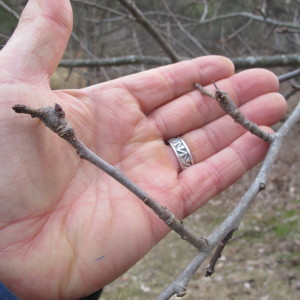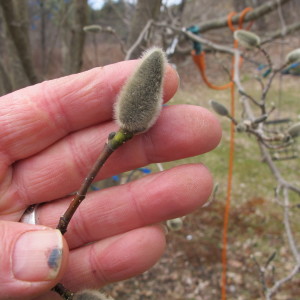Forcing Shrubs to Bloom – Now!
I don’t know about you, but I am more than ready for spring blossoms. My little bulbs like snowdrops are blooming already, but I want my magnolia, crabapples, forsythia and daphne to bloom, too. Fortunately, I can easily speed up the process –indoors. Here’s what I’m doing.
I have cut branches with flower buds and brought them inside to force them in a vase of water. It’s important to know what to look for when you cut branches to force.
Let’s start with apples. What you need to cut are older branches with little stubby outgrowths on them. Those stubs are called fruit spurs, and if they are at least 2 years old, they should produce flowers and as well as leaves. Most apple trees also create pencil-thin straight new shoots each year. These are called water sprouts and will not produce blossoms in a vase, only leaves. Sometimes I pick water sprouts, too, as even leaves are pleasant in early spring.
Fruit spurs most often are produced on branches that are growing at a 30 to 45 degree angle to the trunk or a main branch. Some young trees tend to be very vertical, sending most branches virtually straight up. If you bend a vertical branch to a broader angle, it will often develop fruit spurs in a year or two. Just tie it in place from now until early June and it should stay at the new angle.
An apple fruit spur produces not one flower, but a few, and leaves, too. Just put the branches in a vase of water in a sunny window. In a week or more the branches will burst open with blossoms. When I prune fruit trees, including apples, crabapples and pears, I regard the branches carefully and pick those most loaded with fruit spurs to bring into the house.
Some 20 years ago I planted a small magnolia in my back yard in the middle of an open lawn. Over the years it has reached full size – perhaps 25 feet tall and nearly as wide – and it blooms reliably on my birthday in late April. I have already cut some branches and put them in a vase, and they will bloom indoors within a week or so.
My magnolia is a ‘Merrill’ hybrid. It is a perfect 4-season plant. In the spring mine has more than a thousand 4-inch, lightly fragrant blossoms. In the summer it has glossy green leaves, and no pests. In the fall it displays colorful seeds and bright yellow foliage. In the winter the buds that will open in spring look like pussy
willows on steroids. And it is growing in moist soil near a stream, a location where many trees would not thrive (many do not like wet feet) . Other than the ancient, stately maples on my property, it is my favorite tree.
Then there is the forsythia, one of the earlier things to bloom in our part of the world. For decades gardeners in northern New England grew old fashioned varieties of forsythia and got blossoms low on the bushes, but not above the snow line. Flower buds on any early-blooming shrub are formed the summer before, and must survive the cold temperatures and winds of winter. Those forsythia buds were not hardy in my zone.
But all that has changed. There are now varieties that are fully hardy in Zone 4 – where temperatures drop to minus 30 degrees Fahrenheit each winter. Prime among them are New Hampshire Gold (developed in my home town of Cornish, NH by the late Paul Joy), Vermont Sun, Meadowlark and Northern Gold. These bloom everywhere. When cutting stems for blossoms, pick vigorous young stems. By now you should see some hints of gold in the buds on those branches.
I‘ve been growing a tidy shrub called February Daphne for a dozen years or so. Its proper botanical name is Daphne mezereum. I love this plant so much that when I got a corgi puppy 10 years ago, my first AKC registered dog, I named her Daphne Mezereum. Of course I call my wonderful dog Daffy (except when she rolls in nasty stuff, when I may use her full name to reprimand her).
February Daphne may bloom somewhere in February – New Jersey, the garden state, for example – but for me it blooms in April. Early April if the weather is mild, like this year. I picked some recently and the buds, nearly open, popped open almost immediately.
The rule of thumb is this: the closer you are to the outdoor bloom date, the quicker a branch will bloom in the house. Lilac, which is still many weeks from blooming for me, will not quickly or easily force in the house now. A week before those buds open? Piece of cake.
On another topic, an important one for gardeners, is the presence of deer ticks in the garden. I recently researched deer ticks and the diseases they carry, including Lyme disease. Ticks are already out and biting. If you wish to go on-line, you can see my piece that gives 7 ways to prevent Lyme disease, along with photos of the ticks. Just go to https://dailyuv.com/
Henry is a UNH Master Gardener and the author of 4 gardening books. He lives and gardens in Cornish Flat, NH. His web site is www.Gardening-Guy.com.





